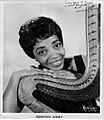Dorothy Ashby facts for kids
Quick facts for kids
Dorothy Ashby
|
|
|---|---|
 |
|
| Background information | |
| Birth name | Dorothy Jeanne Thompson |
| Born | August 6, 1932 Detroit, Michigan, U.S. |
| Died | April 13, 1986 (aged 53) Santa Monica, California |
| Genres | Jazz |
| Occupation(s) | Musician |
| Instruments | Harp, piano, koto |
Dorothy Ashby (born August 6, 1932 – died April 13, 1986) was an American jazz harpist and composer. She was known for making the harp a main instrument in jazz music. Before her, the harp was mostly used for background music or in classical orchestras. Dorothy showed that the harp could play exciting jazz music, just like a saxophone or piano.
Dorothy Ashby faced many challenges in her music career. She was an African American woman in a music world mostly led by men. In an interview, she once said it was a "triple burden." This meant it was hard because not many women were known jazz players, especially black women. Also, the people she wanted to reach weren't usually interested in the harp. But Dorothy worked hard to overcome these challenges. She helped more people enjoy harp music and see what the instrument could do.
Dorothy's music was mostly jazz, but she also mixed in other styles. These included R&B and world music. On her 1970 album The Rubaiyat of Dorothy Ashby, she played the Japanese koto. She was one of the first to successfully use the koto in jazz music.
Contents
Early Life and Learning Music
Dorothy Thompson grew up in Detroit, a city famous for jazz music. Her father, Wiley Thompson, was a guitarist who often brought other jazz musicians home. Even as a young girl, Dorothy would play the piano to support their music.
She went to Cass Technical High School. Many future jazz stars, like Donald Byrd and Kenny Burrell, also went there. In high school, she played several instruments, including the saxophone and string bass. But then she discovered the harp and made it her main instrument.
Dorothy later studied piano and music education at Wayne State University in Detroit.
Her Music Career
After college, Dorothy started playing piano in Detroit's jazz scene. By 1952, she decided to focus on the harp. At first, other jazz musicians weren't sure about the harp. They thought it was only for classical music and sounded too gentle for jazz.
Dorothy worked to change their minds. She put on free shows and played at dances and weddings with her trio. This helped people see the harp as a jazz instrument. She recorded music with famous musicians like Jimmy Cobb and Richard Davis in the late 1950s and early 1960s. In the 1960s, she even had her own radio show in Detroit. She would sometimes play live with her husband and talk about music.
Dorothy also helped bring different kinds of music education to Detroit schools in 1967. Her work inspired music directors to place harps in inner-city schools.
Dorothy's trio, which included her husband, John Ashby, on drums, often toured the country. They recorded many albums. She played with jazz legends like Louis Armstrong and Woody Herman. In 1962, Dorothy won awards from Down Beat magazine for being a top jazz performer.
Her first full jazz album, The Jazz Harpist, came out in 1957. It had a mix of well-known songs and her own music. Critics liked it, but not many people bought it at first. Her next album, Hip Harp (1958), became one of her best. Dorothy recorded ten albums between 1957 and 1970. She was brave with her music choices. She played not just traditional jazz, but also soul, Brazilian, African, and Middle Eastern styles. She even explored free jazz.
Dorothy was a pioneer in using the Japanese koto in jazz. Her 1970 album The Rubaiyat of Dorothy Ashby was special. It blended soul music, world music, and free jazz in a new way.
The Ashby Players: Theater Work
Dorothy also worked with her husband, John Ashby, in a theater company called the Ashby Players. John started the group in Detroit. Dorothy often wrote the music for their plays. In the 1960s, they created plays that were important to the African-American community in Detroit.
John wrote the scripts, and Dorothy wrote the music for these plays. Dorothy also played harp and piano on the soundtracks. She even acted in one play called 3–6–9. Most of the music she wrote for these plays is on special tapes. Only a few songs later appeared on her albums. Later in her career, she would perform concerts and make recordings to help raise money for the Ashby Players' theater productions.
The Ashby Players not only put on black theater shows in Detroit and Canada. They also gave early acting chances to black actors. Ernie Hudson, who later became famous in Ghostbusters, acted in their play 3–6–9.
In the late 1960s, the Ashbys moved to California. Dorothy started working in recording studios. The soul singer Bill Withers helped her get connected, and she worked with Stevie Wonder. This led to her playing the harp on many pop songs.
Her Later Years and Legacy
Dorothy Ashby passed away from cancer on April 13, 1986, in Santa Monica, California.
Her music continues to inspire many artists today. Hip-hop artists often use parts of her songs in their own music. Groups like Jurassic 5 and Ugly Duckling have sampled her harp music. Bonobo also included one of her tracks on his mix album. Her unique sound has influenced many different types of music.
Images for kids
See also
 In Spanish: Dorothy Ashby para niños
In Spanish: Dorothy Ashby para niños


